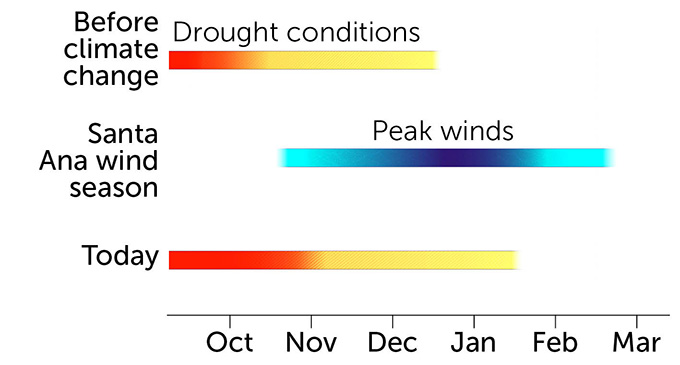
A wicked blustery convergence and prolonged drought has caused destruction in southern California, as fires in Los Angeles have killed at least 28 people and destroyed more than 16,000 structures. According to a new analysis of the world’s weather attributes, this severe number was partially caused by the burning of human fossil fuel.
Hot, dry and windy weather fires became 1.35 times more likely by human -caused climate change, while the lack of rainfall in the previous months may have been made 2.4 times more likely, analysis of issued January 28 tells.
“All parts were in place for a catastrophe of wild rainfall-low rain, a construction of dry Tinder vegetation and strong winds,” said UCLA Park Williams Hydroclimatologist.
The fire season in southern California ends typically when rainfall arrives in October, November or December. But a minority of rainfall at the end of 2024 extended the drying of the region’s vegetation, preparing the landscape to burn. Drawing dryness remained long enough to coincide with a powerful appearance of Santa Anna-a seasonal phenomenon in which hot air, dry from the inner desert areas blows to the California coast. Upon arriving in the city of Angels, Santa Anna winds reached up to 160 kilometers (100 miles) per hour landing the rods of the area, stirring the flames of active flames and spread thieves through the air.
Dear to measure the impact that climate change had on these fire conditions, world -weather researchers, or WWA, compared the possibility of emerging with and without modern climate warming. Since 2014, WWA researchers have been using local weather data and climate simulations to produce dozens of reports that estimate how climate change has affected the probability and intensity of extreme weather events.
For the new study, the WWA team withdrew the decades of decades on temperature, relative humidity, wind speed and rainfall in southern California to carry out some analysis of how hot, dry and windy conditions changed daily from year per year. Researchers also watched how October-December rain models changed through the years and when drought conditions ended every year.
After comparing data with nearly a dozen different climate simulations, researchers concluded that climate change made warm, dry and wind conditions in January about 35 percent more likely and 6 percent more intense compared to The pre -industrial period, which was on average about 1.3 degrees Celsius cooler than today. Such fire pressure conditions are expected to occur once every 17 years on average, researchers report. But if global warming rises to 2.6 degrees C above preindustrial levels – which is projected to occur by 2100 – conditions will be about 1.8 times more likely than today.
Moreover, Los Angeles’s dry season now lasts approximately 23 days longer than in pre -industrial times, the data show. This suggests that man -induced climate change is helping to delay the end of drought conditions, promoting an overlap with the Santa Ana Era season.
Researchers were unable to clearly simulate the link between climate change and low levels of seasonal rainfall or dry season extension using computer models, partly due to the relatively small size of the Los Angeles area compared to the wide level of details in models. This meant that the team could not finally blame the climate change only for the reduced rainfall leading to the fire, or for the additional 23 days of dry conditions.
But other studies that have evaluated the wider region of southern California have shown that climate change is delaying the end of the dry season, said Friederic Climate Otto of Imperial College London at a January 28 news conference.
“We can officially say that climate change plays a role in this,” Otto said.
#blame #climate #change #fires
Image Source : www.sciencenews.org
